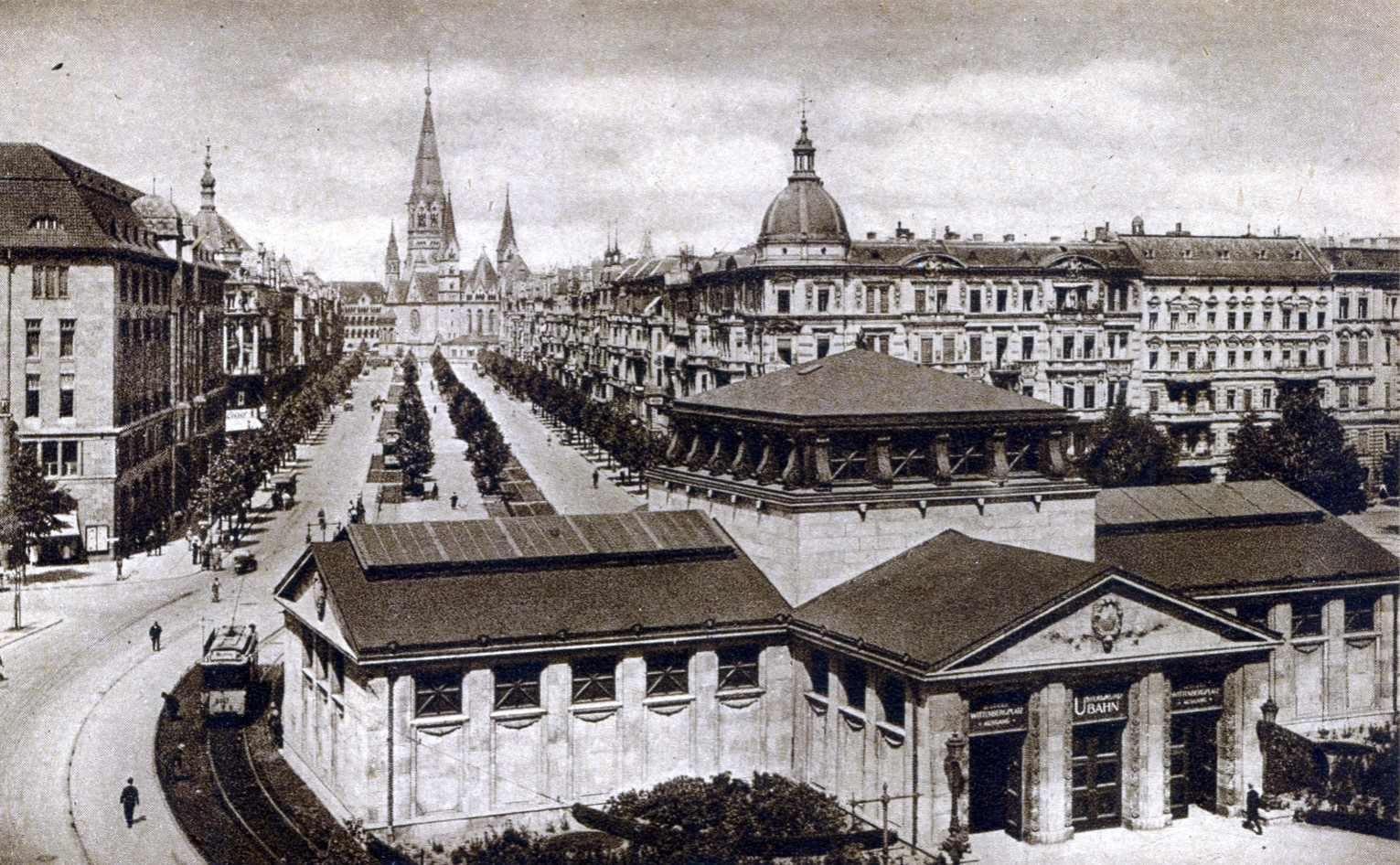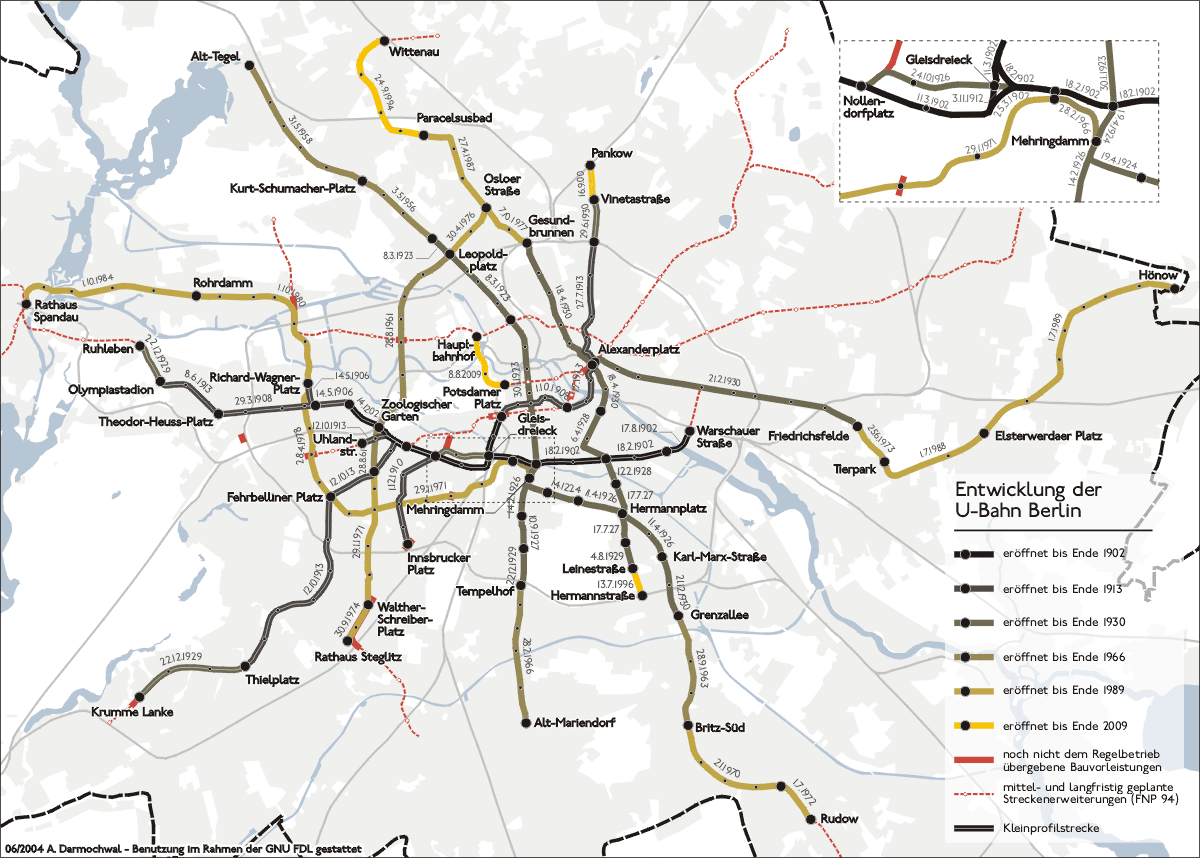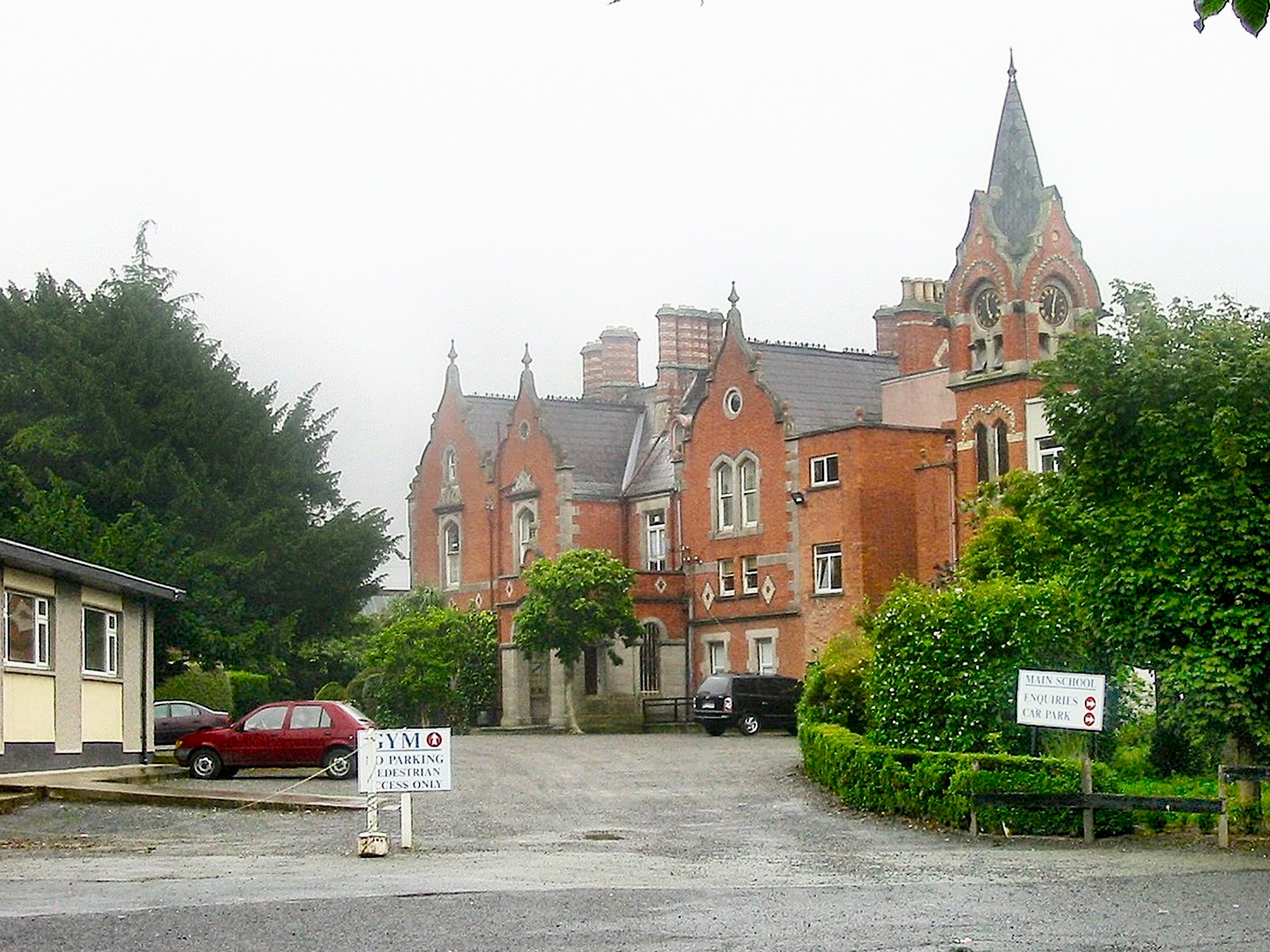|
Wittenbergplatz (Berlin U-Bahn)
Wittenbergplatz is a Berlin U-Bahn station on lines U1, U2, and U3. The station is located at the Wittenbergplatz square in Berlin's City West area, in the northwestern corner of the Schöneberg neighbourhood. It is the only U-Bahn station in the city with five adjacent tracks and three platforms. The station building, erected in 1911–1913 according to plans designed by Alfred Grenander, is listed as an architectural monument. History Wittenbergplatz is one of the oldest U-Bahn stations in Berlin, opened on 11 March 1902 with the first '' Stammstrecke'' (present-day U1) line running under the eponymous square and adjacent to Tauentzienstraße, today one of the major shopping streets in Berlin. Initially a common underground station with two tracks and two side platforms, it was completely refurbished as an interchange from 1910 onwards. The new station serving three U-Bahn lines opened on 1 December 1912 with two island platforms and one side platform, serving five tracks ... [...More Info...] [...Related Items...] OR: [Wikipedia] [Google] [Baidu] |
Schöneberg
Schöneberg () is a locality of Berlin, Germany. Until Berlin's 2001 administrative reform it was a separate borough including the locality of Friedenau. Together with the former borough of Tempelhof it is now part of the new borough of Tempelhof-Schöneberg. History The village was first documented in a 1264 deed issued by Margrave Otto III of Brandenburg. In 1751, Bohemian weavers founded Neu-Schöneberg also known as Böhmisch-Schöneberg along northern Hauptstraße. During the Seven Years' War on 7 October 1760 Schöneberg and its village church were completely destroyed by a fire due to the joint attack on Berlin by Habsburg and Russian troops. Both Alt-Schöneberg and Neu-Schöneberg were in an area developed in the course of industrialization and incorporated in a street network laid out in the Hobrecht-Plan in an area that came to be known architecturally as the Wilhelmine Ring. The two villages were not combined as one entity until 1874 and received town privil ... [...More Info...] [...Related Items...] OR: [Wikipedia] [Google] [Baidu] |
History Of The Berlin U-Bahn
The Berlin U-Bahn originated in 1880 with Werner Siemens' idea to build an urban railway in Berlin. During the nine years after the German Empire was founded, the city's population grew by over one-third and traffic problems increased. In 1896, Siemens & Halske began to construct the first stretch of overhead railway. On 1 April 1897, the company began construction of an electric underground railway. The Berliner Verkehrs Aktiengesellschaft (BVG) was formed in 1928, and took over further construction and operation of the network. In 1938, the company was renamed Berlin Transport Company; the original acronym, however, remained. Since 1994, the BVG has been a public company. The line between Stralauer Tor and Potsdamer Platz (the present-day U1 line) was the first to open, on 18 February 1902. Four additional lines were built before the First World War. In the Weimar Republic, hyperinflation initially prevented further expansion of the system. A new line with a wider car, kno ... [...More Info...] [...Related Items...] OR: [Wikipedia] [Google] [Baidu] |
U2 (Berlin U-Bahn) Stations
U2 are an Irish Rock music, rock band from Dublin, formed in 1976. The group consists of Bono (lead vocals and rhythm guitar), the Edge (lead guitar, keyboards, and backing vocals), Adam Clayton (bass guitar), and Larry Mullen Jr. (drums and percussion). Initially rooted in post-punk, U2's musical style has evolved throughout their career, yet has maintained an anthemic quality built on Bono's expressive vocals and the Edge's chiming, Effects unit, effects-based guitar sounds. Bono's lyrics, often embellished with spiritual imagery, focus on personal and sociopolitical themes. Popular for their live performances, the group have staged several ambitious and elaborate tours over their career. The band was formed when the members were teenaged pupils of Mount Temple Comprehensive School and had limited musical proficiency. Within four years, they signed with Island Records and released their debut album, ''Boy (album), Boy'' (1980). Works such as their first UK number-one album, ' ... [...More Info...] [...Related Items...] OR: [Wikipedia] [Google] [Baidu] |
U1 (Berlin U-Bahn) Stations
U1, U.I or U-1 may refer to: Mathematics *U(1), the degree one ''unitary group'' Military *U-1, the USAF and US Military's designation for the De Havilland Canada DHC-3 Otter light transport aircraft *U-1, Soviet designation for Avro 504 trainer. *Multiple German U-boats named ''U-1'' *Oberursel U.I, an early German aircraft engine *HDMS U-1, a Danish submarine * SM U-1, an Austro-Hungarian submarine, lead ship of the U-1 class Entertainment * U1 Technology, a game and software developing company *'' Ultima I: The First Age of Darkness'', a 1981 video game People * U1, alias for Yuvan Shankar Raja (born 1979), a Tamil musician and film composer *U-1, the main character in the video game '' Gitaroo Man'' for the PlayStation 2/PlayStation Portable Railways * LNER Class U1, a 1924 British solitary 2-8-0+0-8-2 Beyer-Garratt locomotive *SR U1 class, a class of 2-6-0 locomotives developed from the U Class U-Bahn lines * U1 (Berlin U-Bahn) *U1 (Frankfurt U-Bahn) * U1 (Hamburg U-Ba ... [...More Info...] [...Related Items...] OR: [Wikipedia] [Google] [Baidu] |
London Underground
The London Underground (also known simply as the Underground or by its nickname the Tube) is a rapid transit system serving Greater London and some parts of the adjacent counties of Buckinghamshire, Essex and Hertfordshire in England. The Underground has its origins in the Metropolitan Railway, the world's first underground passenger railway. Opened on 10 January 1863, it is now part of the Circle, District, Hammersmith & City and Metropolitan lines. The first line to operate underground electric traction trains, the City & South London Railway in 1890, is now part of the Northern line. The network has expanded to 11 lines, and in 2020/21 was used for 296 million passenger journeys, making it one of the world's busiest metro systems. The 11 lines collectively handle up to 5 million passenger journeys a day and serve 272 stations. The system's first tunnels were built just below the ground, using the cut-and-cover method; later, smaller, roughly circular tu ... [...More Info...] [...Related Items...] OR: [Wikipedia] [Google] [Baidu] |
London Transport Executive
The London Transport Executive was the organisation responsible for public transport in Greater London, England between 1948 and 1962. In common with all London transport authorities from 1933 to 2000, the public name and operational brand of the organisation was London Transport. Formation On 1 January 1948, pursuant to the Transport Act 1947, the London Passenger Transport Board (LPTB) was nationalised and renamed the London Transport Executive (LTE), becoming a subsidiary organisation of the British Transport Commission, which was formed on the same day. Another subsidiary of the commission was the Railway Executive (which traded as British Railways), which meant that London Transport and the main-line railways were under the same management for the first and last time in their respective histories. Projects A great deal of the early work of the LTE was spent repairing and replacing stock and stations damaged during World War II. LTE also oversaw the completion of the ... [...More Info...] [...Related Items...] OR: [Wikipedia] [Google] [Baidu] |
U-Bahn Berlin Wittenberplatz London
Rapid transit in Germany consists of four U-Bahn systems and fourteen S-Bahn systems. The U-Bahn commonly understood to stand for Untergrundbahn (''underground railway'') are conventional rapid transit systems that run mostly underground, while the S-Bahn or Stadtschnellbahn (''city rapid railway'') are commuter rail services, that may run underground in the city center and have metro-like characteristics in Munich, Hamburg and Berlin which they only have to a lesser extent in other cities. There are also over a dozen premetro or Stadtbahn systems that are rapid transit in the city center and light rail outside. There are four U-Bahn systems, namely in Berlin, Hamburg, Munich and Nuremberg; these are all run by the transit authorities in the city. Some cities call their Stadtbahn "U-Bahn" (like Frankfurt) or abbreviate their Stadtbahn with a U. The confusing term "U-Stadtbahn" is also used on occasion and as "U-Bahn" is often seen as the more desirable term, common parlance and ... [...More Info...] [...Related Items...] OR: [Wikipedia] [Google] [Baidu] |
Nollendorfplatz (Berlin U-Bahn)
Nollendorfplatz is a Berlin U-Bahn station on lines U1, U2, U3, and U4. It opened in 1902, and today is the only station in Berlin that is served by four U-Bahn lines, and the only one served by all of the ''Kleinprofil'' (small profile) lines. Overview The station, and the plaza named after Nakléřov in the Czech Republic, lies in the north of Schöneberg at the junction of Motzstraße, Kleiststraße and Bülowstraße. The area is an important centre of gay culture, and the nearby Winterfeldtplatz is home to a well known market. It became a more run down centre of heroin addiction, punks, and squatters in the 1970s and early 1980s, and has seen a comeback into the (somewhat intellectual) mainstream culture with higher rents and upscale restaurants and bookshops. In this it resembles (and indeed was a role model for) the western part of Kreuzberg. In 2002, the station was given an Art Nouveau Art Nouveau (; ) is an international style of art, architecture, and ap ... [...More Info...] [...Related Items...] OR: [Wikipedia] [Google] [Baidu] |
Berlin Wall
The Berlin Wall (german: Berliner Mauer, ) was a guarded concrete barrier that encircled West Berlin from 1961 to 1989, separating it from East Berlin and East Germany (GDR). Construction of the Berlin Wall was commenced by the government of the GDR on 13 August 1961. It included guard towers placed along large concrete walls, accompanied by a wide area (later known as the "death strip") that contained anti-vehicle trenches, beds of nails and other defenses. The Eastern Bloc portrayed the Wall as protecting its population from fascist elements conspiring to prevent the "will of the people" from building a socialist state in the GDR. The authorities officially referred to the Berlin Wall as the ''Anti-Fascist Protection Rampart'' (german: Antifaschistischer Schutzwall, ). The West Berlin city government sometimes referred to it as the "Wall of Shame", a term coined by mayor Willy Brandt in reference to the Wall's restriction on freedom of movement. Along with the ... [...More Info...] [...Related Items...] OR: [Wikipedia] [Google] [Baidu] |
West Berlin
West Berlin (german: Berlin (West) or , ) was a political enclave which comprised the western part of Berlin during the years of the Cold War. Although West Berlin was de jure not part of West Germany, lacked any sovereignty, and was under military occupation until German reunification in 1990, the territory was claimed by the Federal Republic of Germany (FRG) which was heavily disputed by the Soviet Union and other Eastern Bloc countries. However, West Berlin de facto aligned itself politically with the FRG on 23 May 1949, was directly or indirectly represented in its federal institutions, and most of its residents were citizens of the FRG. West Berlin was formally controlled by the Western Allies and entirely surrounded by the Soviet-controlled East Berlin and East Germany. West Berlin had great symbolic significance during the Cold War, as it was widely considered by westerners an "island of freedom" and America's most loyal counterpart in Europe. It was heavily subsidi ... [...More Info...] [...Related Items...] OR: [Wikipedia] [Google] [Baidu] |
Bombing Of Berlin In World War II
A bomb is an explosive weapon that uses the exothermic reaction of an explosive material to provide an extremely sudden and violent release of energy. Detonations inflict damage principally through ground- and atmosphere-transmitted mechanical stress, the impact and penetration of pressure-driven projectiles, pressure damage, and explosion-generated effects. Bombs have been utilized since the 11th century starting in East Asia. The term bomb is not usually applied to explosive devices used for civilian purposes such as construction or mining, although the people using the devices may sometimes refer to them as a "bomb". The military use of the term "bomb", or more specifically aerial bomb action, typically refers to airdropped, unpowered explosive weapons most commonly used by air forces and naval aviation. Other military explosive weapons not classified as "bombs" include shells, depth charges (used in water), or land mines. In unconventional warfare, other names can refer ... [...More Info...] [...Related Items...] OR: [Wikipedia] [Google] [Baidu] |
Kaufhaus Des Westens
The Kaufhaus des Westens (), abbreviated to KaDeWe, is a department store in Berlin, Germany. With over of retail space and more than 380,000 articles available, it is the second-largest department store in Europe after Harrods in London. It attracts 40,000 to 50,000 visitors every day. The store is located on Tauentzienstraße, a major shopping street, between Wittenbergplatz and Breitscheidplatz, near the heart of former West Berlin. It is technically in the extreme northwest of the south Berlin neighborhood of Schöneberg. Since 2015, KaDeWe has been owned by the Central Group, a Thailand-based international department store conglomerate. History Empire and Weimar Republic: the Jandorf Era The businessman Adolf Jandorf had opened six stores for basic needs with his company ''A. Jandorf & Co.'' in Berlin by 1905. Like the competitor stores ''Wertheim Leipziger Strasse'' (1894) and the ''Warenhaus Tietz'' (1900), also on Leipziger Strasse, Jandorf wanted to cater for the ... [...More Info...] [...Related Items...] OR: [Wikipedia] [Google] [Baidu] |





.png)
